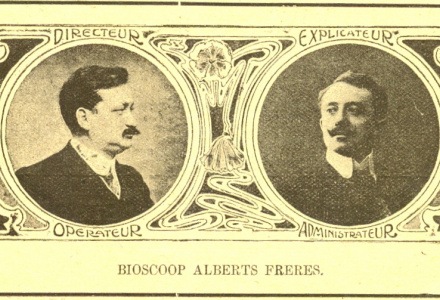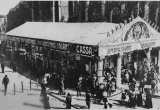Film Shows by Alberts Frères
A luxurious movie tent with full evening programmes, musical accompaniment and Willy Mullens as an rousing explicateur, or lecturer – that was the formula that made Alberts Frères rising stars in 1905. The Mullens brothers also made use of very clever programming: they combined the best new foreign productions with the ever-popular local films that were starting to take on a more fictional character.
Every few days the programme was changed, and only the hits remained in the repertoire. In this way, they brought in new audiences who wanted to see the hits, while others came for the new films. This strategy was partnered with a publicity campaign that included flooding local journalists with positive reviews about earlier screenings. Matinees for children and exclusive closing night gala screenings with a major film (often the long film La vie et la Passion du Jésus Christ; Pathé Frères) rounded off the programme.
Albert and Willy Mullens spent the winter months with the artists’ society, Haagse Kunstkring, where they showed films a few times a week. This was a first step on the road to a permanent place to show their motion pictures.
The concept of the Alberts Frères film shows was copied by colleagues such as Alex Benner, Henricus Hommerson and Jean Desmet until the emergence of the first purpose-built cinemas around 1910 undermined the raison d’être for travelling film shows. Benner became the director of a cinema, just like Desmet who also went into film distribution. Hommerson exchanged travelling film shows for other fairground attractions.
more information
If you are looking for more material from our collection, please contact Film Sales:
sales@eyefilm.nl
phone +31 (0)20 5891 426

